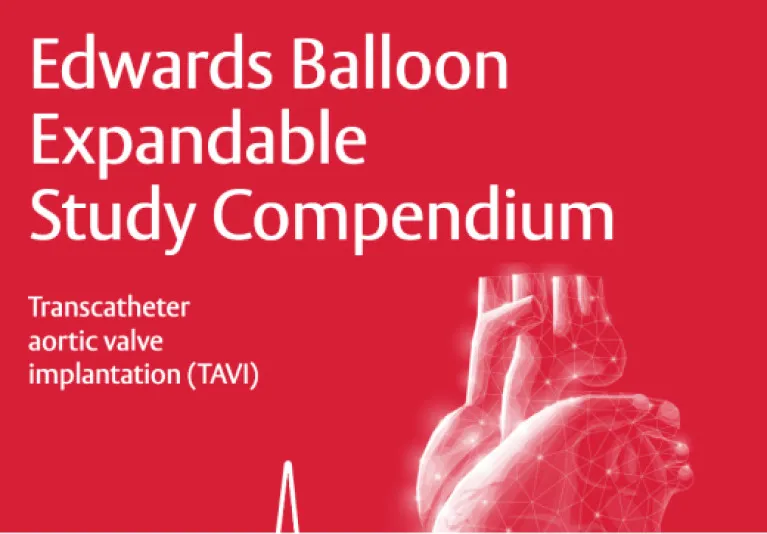PARTNER 1B Trial - TAVI shows superior outcomes compared to standard therapy1-3
- A large, multicentre trial enrolling inoperable severe aortic stenosis (sAS) patients randomised to TAVI or standard therapy
- The rate of death from any cause (primary endpoint) was superior with TAVI than with standard therapy at 1 year and at 5 years
- TAVI significantly improved KCCQ overall summary score from baseline at 1 month, 6 months and 12 months in inoperable patients receiving TAVI
The PARTNER 1B Trial study design1

Inclusion and exclusion criteria
Inclusions1
- Severe aortic valve stenosis (aortic valve area <0.8 cm2 or mean gradient >40 mm Hg or peak velocity >4.0 m/s)
- Síntomas cardíacos (clase NYHA ≥II)
- Inoperability (risk of death or irreversible severe morbidity of at least 15% according to the assessment of a Heart Team consisting of one cardiologist and two cardiac surgeons)
Exclusions1
- Evidence of an acute myocardial infarction ≤1 month before the intended treatment
- Aortic valve is a congenital unicuspid or bicuspid valve; or is non-calcified
- Mixed aortic valve disease (aortic stenosis and aortic regurgitation with predominant aortic regurgitation >3+)
- Any therapeutic invasive cardiac procedure performed within 30 days of the index procedure (or 6 months if the procedure was a drug eluting coronary stent implantation)
- Pre-existing prosthetic heart valve in any position, prosthetic ring, or severe (greater than 3+) mitral insufficiency
Baseline characteristics
The baseline characteristics of the patients in the TAVI and standard therapy groups were generally well balanced. The exceptions were a lower percentage of patients with COPD and atrial fibrillation in the TAVI group compared to the standard therapy group (41.3% vs 52.5%, p=0.04 and 32.9% vs 48.8%, p=0.04, respectively). The overall patient population was at high risk.1*
* Plus–minus values are means ±SD.
† Scoring on the risk model of the Society of Thoracic Surgeons (STS) uses an algorithm that is based on the presence of coexisting illnesses in order to predict 30-day operative mortality. The STS score equals the predicted mortality expressed as a percentage. Less than 5% of patients in the population on which the STS algorithm is based had a predicted operative mortality (risk score) of more than 10%.
‡ To convert values for creatinine to micromoles per litre, multiply by 88.4
Reported clinical and patient outcomes
Primary endpoint with added 5-year follow-up data
The rate of death was significantly lower with TAVI than with standard therapy at 1 year and 5 years1,2
At 1 year:1
- All-cause mortality occurred in 55 patients (30.7%) in the TAVI group versus 89 patients (50.7%) in the standard therapy group (absolute difference 20%, p<0.001)
- The composite endpoint of death or rehospitalisation occurred in 76 patients (42.5%) in the TAVI group versus 126 patients (70.4%) in the standard therapy group (p<0.001)
At 5 years:2
- All-cause mortality occurred in 71.8% of patients in the TAVI group versus 93.6% of patients in the standard therapy group (absolute difference 21.8%, p<0.0001)

* Prolonged follow-up
† Denotes values for stroke only in the inoperable group at 5 years.
‡ P-value is for TAVI versus sAVR/standard treatment for the full range of functional classes.
Quality of life
Inoperable patients receiving TAVI enjoyed an improved health status at 1, 6 and 12 months after the procedure from baseline, as measured using the KCCQ-OS (Kansas City Cardiomyopathy Questionnaire – Overall Summary)3

TAVI also resulted in significant improvements in health-related quality of life, compared with standard therapy, that was maintained for at least 1 year.3
Find out more about the QoL analysis and see the full outcome data
Clinical implications
What could a TAVI referral mean for your patients who match the PARTNER 1B Trial characteristics?
- For inoperable patients with sAS, TAVI offered significantly improved survival and a more effective reduction of symptoms compared with standard therapy. In this severely ill patient group, a survival benefit was still evident even after five years1,2
- Despite multiple comorbidities and advanced age, patients similar to those enrolled in the PARTNER Trial could expect meaningful improvements in symptoms, functional status, and quality of life after TAVI3
References:
1 Leon MB, et al. N Engl J Med 2010;363:1597-1607 and supplementary material.
2 Kapadia SR, et al. Lancet 2015;385:2485-2491.
3 Reynolds MR, et al. Circulation. 2011;124:1964-1972.
Medical device for professional use. For a listing of indications, contraindications, precautions, warnings, and potential adverse events, please refer to the Instructions for Use (consult eifu.edwards.com where applicable).
PP--EU-0773 v2.0
